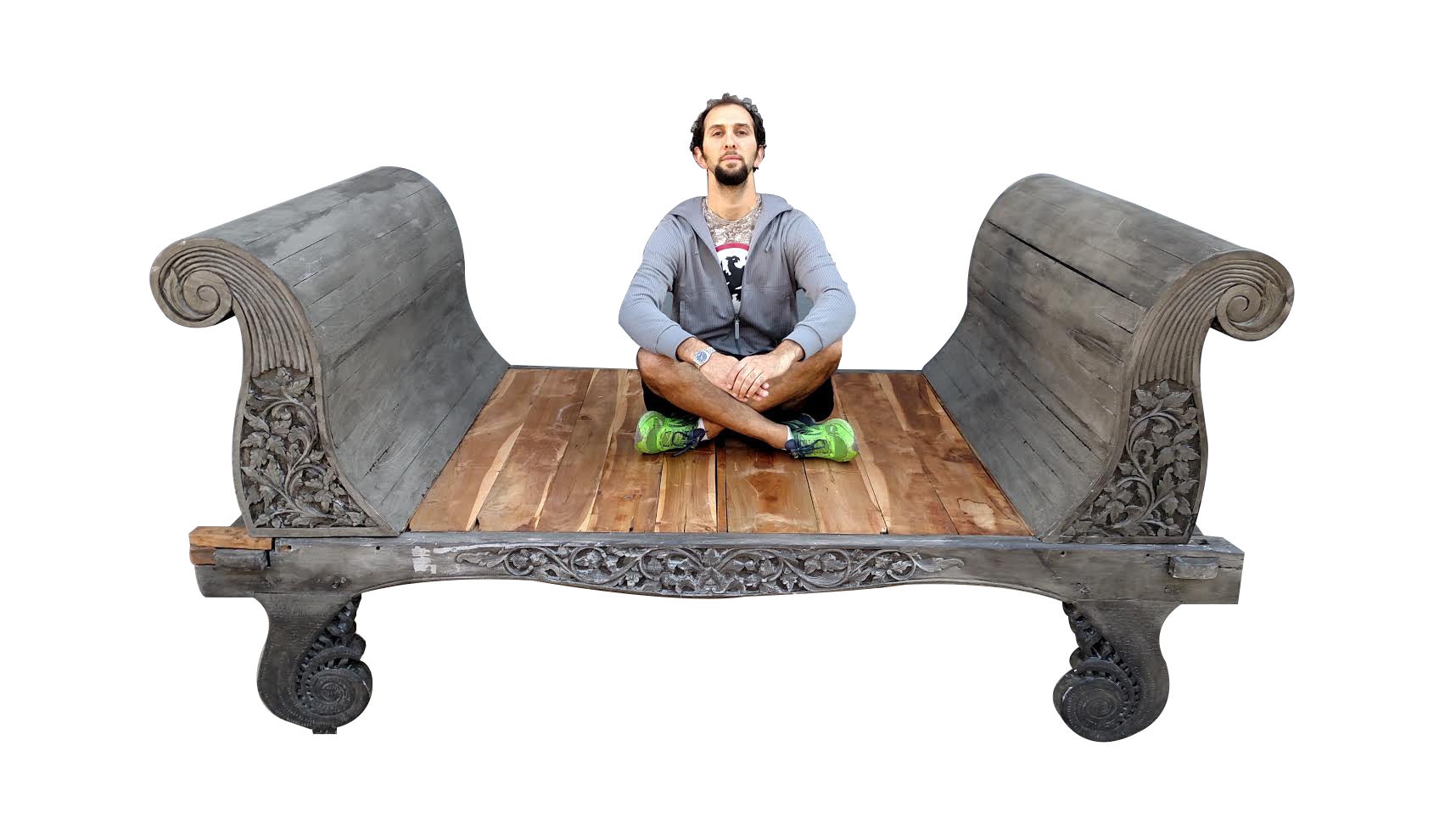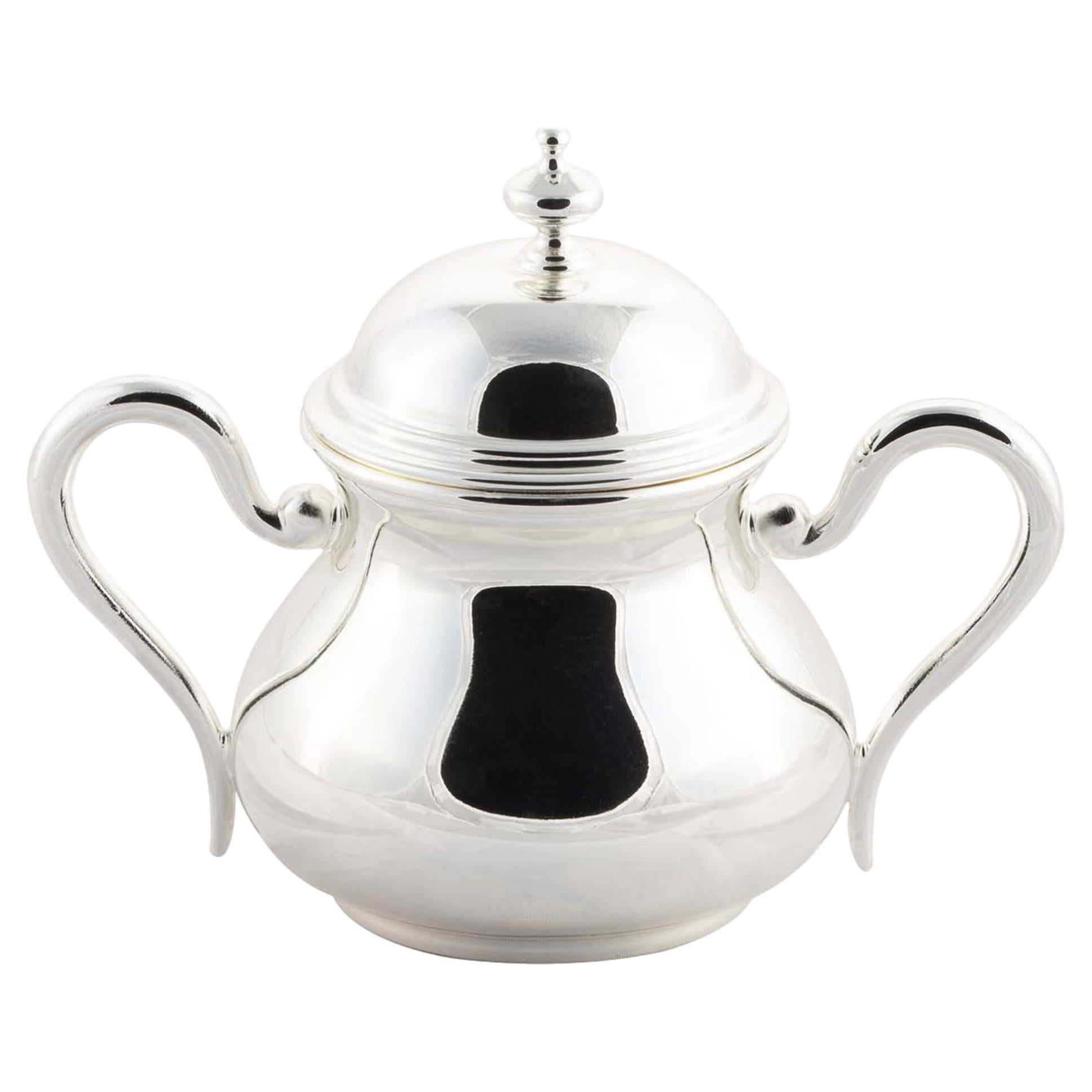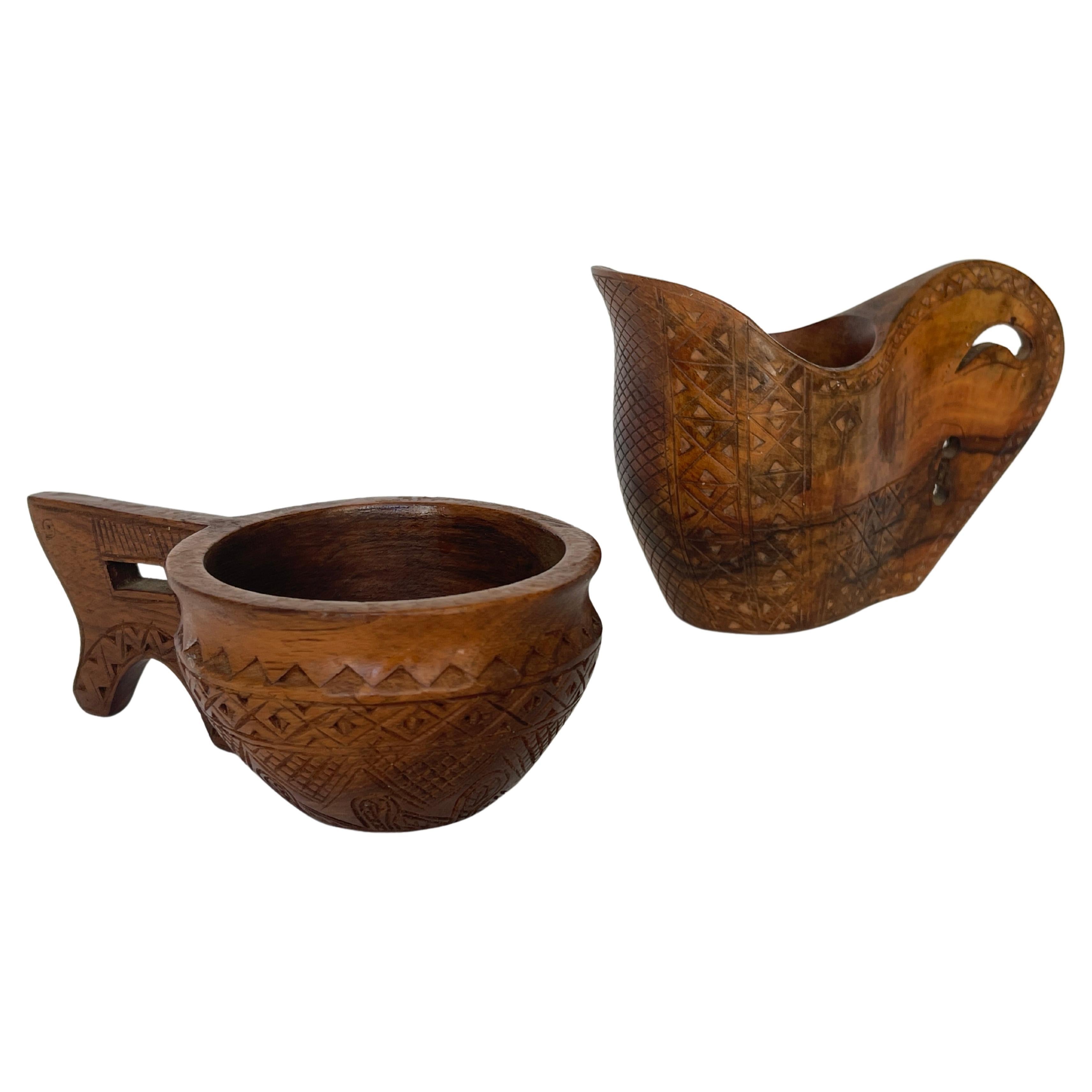Items Similar to Antique English Colonial Pewter Creamer Pitcher & Sugar Bowl Serving Set
Want more images or videos?
Request additional images or videos from the seller
1 of 13
Antique English Colonial Pewter Creamer Pitcher & Sugar Bowl Serving Set
About the Item
Antique English Colonial or Renaissance style creamer and sugar bowl set. Marked on base England with pseudo hallmark featuring a crowned shield, dragon head, lion passant, and sword in shield shaped cartouches. Measure: 5.5".
- Dimensions:Height: 4 in (10.16 cm)Width: 5.5 in (13.97 cm)Depth: 3.5 in (8.89 cm)
- Sold As:Set of 2
- Style:British Colonial (In the Style Of)
- Materials and Techniques:
- Period:
- Date of Manufacture:Early 20th Century
- Condition:Wear consistent with age and use. Good Overall - Gentle wear.
- Seller Location:Dayton, OH
- Reference Number:

About the Seller
4.9
Platinum Seller
These expertly vetted sellers are 1stDibs' most experienced sellers and are rated highest by our customers.
Established in 2010
1stDibs seller since 2020
1,112 sales on 1stDibs
Typical response time: <1 hour
- ShippingRetrieving quote...Ships From: Dayton, OH
- Return PolicyA return for this item may be initiated within 2 days of delivery.
More From This SellerView All
- 3 Antique H. Homan & Co Pewter Tea Coffee Teapot Sugar Bowl CreamerLocated in Dayton, OH"Set of three antique pewter pieces circa late 19th century - 1880’s to early 1890’s – the set includes a teapot and lidded sugar bowl with etched flowers and floral finial, and plain creamer with floral finial. Pieces are marked Homan & Co Cincinnati 3, H. Homan IX, and Homan & Co Cincinnati IX. ""Homan Manufacturing Company was founded in Cincinnati Ohio in 1847 by Henry Homan and Asa F. Flagg as manufacturers of Britannia ware under the name Flagg & Homan. The Homan family managed the business as Homan & Co until 1887, gradually changing from the manufacture of pewter, Britannia metal and German silver to electroplated silverware. Around 1896 the name of the firm was Homan Silver Plate Company...Category
Antique 1880s Victorian Tea Sets
MaterialsPewter
- Antique English Staffordshire Transferware Serving Creamer Jug PitcherLocated in Dayton, OH"Antique 20th century Staffordshire transferware porcelain jug or pitcher featuring an English landscape in black, originally designed by James Cutts for W. Adams & Sons, and a yellow border around the upper edge. “James Cutts was born in 1808 in Pinxton, Derbyshire, he was the 9th of 10 children and the youngest of five boys. His father, John Cutts, was a moderately gifted china painter, trained at the Derby porcelain works, who moved to become manager of the Pinxton porcelain...Category
Early 20th Century Late Victorian Porcelain
MaterialsPorcelain
- Antique Cut Crystal Floral Daisy Bar Drink Serving Pitcher & 6 GlassesLocated in Dayton, OHAntique heavy cut crystal pitcher and six tumbler glasses featuring floral daisy design. Dimensions: Pitcher - 7” x 5.25” x 6.5” / Glasses - 3.125” x 4” (Width x Depth x Height)Category
Early 20th Century Serving Pieces
MaterialsCrystal
- Antique William Roger Quadruple Plate Sugar Bowl & Gorham Sterling Silver SpoonsBy William Rogers, Gorham Manufacturing CompanyLocated in Dayton, OHAntique turn of the century 13 piece sugar bowl and hanging spoon set, featuring a trophy urn style bowl with etched palm leaves on the body, brackets to support twelve sugar spoons, squirrels in the pierced handles and a sparrow shaped finial. Set includes 11 Gorham sterling silver demitasse spoons in the New Queens pattern (introduced 1895); sold by J.E. Caldwell & Co. Bowl and lid by William Rogers (cross and keystone mark, circa 1900-1910), design number 57. "Gorham Silver was founded in Providence, Rhode Island, in 1831 by Jabez Gorham, a master craftsman, in partnership with Henry L. Webster. The firm's chief product was spoons of coin silver, but also made thimbles, combs, jewelry, and other small items. In 1865, the Rhode Island legislature granted a charter in the name of Gorham Manufacturing Company. During the heyday of American silver manufacturing, approximately 1850–1940, Gorham was highly influential. The company has produced matching hollowware in both sterling and silverplate, as well as running a foundry for bronze sculpture. The White House has used Gorham silver services during many administrations including those of Lincoln, Grant, and George W. Bush. Gorham artisans also sculpted several famous statues housed in the Capitol's Rotunda, overlooking the Museum of Natural History in New York, and topping the Rhode Island State House. Gorham has also designed a number of elaborate trophies for sporting events, including the Borg-Warner Trophy for the Indianapolis 500, designed by Robert J. Hill. The company has changed hands multiple times beginning with Textron (1967), to Dansk International Designs (1989), to Brown-Forman Corporation (1991), to the Lenox Group (2005), to Clarion Capital Partners (2009), now operating under the name Lenox Corporation." "William Hazen Rogers (born May 13, 1801) was an American master silversmith and a pioneer in the silver-plate industry and whose work and name have survived to the present day. Rogers partnered with other silversmiths at times, and his company and trademarks were eventually taken over by larger companies. Rogers was born on a farm on May 13, 1801, to Sarah Reynolds (1777-?) and Asa Rogers (1798-1824). After he left home, he went on to become a silversmith, watchmaker and jeweler. From 1820 to 1825, Rogers was an apprentice to Joseph Church, a silversmith and watchmaker in Hartford. In 1825, Rogers became partners with Church and their company, Church & Rogers, initially manufactured silver-plate flatware and hollowware. He was also partner, from 1832 to 1838, with Asa Harris Rogers, his younger brother, as "A Rogers Jr. & Co." while still associated with Church & Rogers. Rogers – together with his two brothers and, later, his son – was responsible for more than 100 patterns of silver and silver-plated cutlery and serving dishes. Many of Roger's designs were influenced by Louis XIV-style patterns of the 17th and 18th century in France, and he was best known for his Elberon pattern and "Presidential" cutlery series. The companies in which one or more of the original...Category
Early 20th Century Late Victorian Serving Pieces
MaterialsMetal, Sterling Silver
- 2 Antique 18th Century Pewter Pedestal Master Salt Cellar Trencher Bowls CupsLocated in Dayton, OHPair of rare antique 18th century pewter salt cellars / bowls / pedestal dishes or footed cups with unique scalloped and swirled form. Measure: 3".Category
Antique 18th Century British Colonial Serving Pieces
MaterialsPewter
- 10 Pc English Hammersley & Co Rose Point Strawberry Basket Tea Serving SetBy Shelley Pottery, HammersleyLocated in Dayton, OH#38183 Vintage 10 piece serving set by Hammersley & Company. White bone china with gilded details. Set includes handled serving tray with creamer and sugar bowl in the Rose Point pattern, butter dish and lid, and five flower shaped nut dishes / coasters by Shelley England. "Hammersley & Company - The company was founded in Longton, England, in 1862. It was established as Adams, Scrivener & Co. The third owner was Titus Hammersley. After Mr. Scrivener's retirement, the company was continued by Adams and Hammersley as Harvey Adams & Co. Titus Hammersley died in 1875, and was succeeded by his eldest son, George Harris Hammersley. Finally, in 1885, Harvey Adams retired, leaving George Hammersley in charge of Hammersley & Co. His partner in the firm was Sarah Hammersley. Three years later, the management was taken over by Gilbert Hemmersley (George's brother). Later, Gilbert's sons Eric and Leslie joined the company. In 1932, the company was renamed Hammersley and Co (Longton) Ltd. They moved from the Sunderland Road Works in Longton to the Alsager Pottery. Alsager China was used as a trademark. In 1970, the company was purchased by Carborundum Limited, which merged with Royal Worcester six years later to form Royal Worcester Spode Ltd. In 1982, the Hammersley name was purchased by Palissy Pottery Ltd. However, Hammersley's Works were closed. In 1989, the Hammersley name was bought by Aynsley China, which operated until 2014, when the factory closed." "Shelley Potteries, situated in Staffordshire, was earlier known as Wileman & Co. which had also traded as The Foley Potteries. The first Shelley to join the company was Joseph Ball Shelley in 1862 and in 1896 his son Percy Shelley became the sole proprietor, after which it remained a Shelley family business until 1966 when it was taken over by Allied English Potteries. Its china and earthenware products were many and varied although the major output was table ware. In the late Victorian period the Art Nouveau style pottery and Intarsio ranges designed by art director Frederick Alfred Rhead were extremely popular but Shelley is probably best known for its fine bone china “Art Deco” ware of the inter-war years and post-war fashionable tea ware. Wileman refers to a backstamped version of which predates Shelley-branded porcelain. The factory that manufactured this brand of porcelain was located in Longton, Staffordshire, England. The origins of Shelley pottery were in the district known as Foley, at the factory of Messrs. Elkin, Knight & Bridgwood which by 1829 had a powerful steam engine and flint Mill. Knight became sole proprietor of the business in 1853 but shortly afterwards took Henry Wileman as a partner, trading as Knight & Wileman. Three years later Knight retired and Henry Wileman continued the business in his own name. In 1862 Henry Wileman employed Joseph Shelley as a travelling salesman. In 1864 Henry Wileman died and his two sons James F and Charles J took over the business. Two years later the business was split, James managed the earthenware factory whilst Charles managed the china factory. Charles Wileman retired in 1870 and James became sole proprietor of this factory. Joseph Shelley was taken into partnership with James Wileman in 1872, but only for the china factory. The company became known as Wileman & Co and used the backstamp "Foley". In 1881 Joseph's son Percy Shelley joined the company. Joseph Shelley died in June 1896, leaving Percy in sole control of the company. Notable early designers and arts directors of the company included Rowland Morris (1896), Frederick Alfred Rhead (1896), Walter Slater (ca. 1905). Shortly before the 1st World War two of Percy’s sons, Percy Norman and Vincent Bob, joined the family company. Kenneth Jack, the other son, joined as well after the war. In 1919 Eric Slater, Walter’s son joined the company. The company was still called Wileman & Co, even though it had been controlled by the Shelley family for over fifty years and on 1 January 1925 the Shelley name and trademark was registered. In the mid twenties Shelley broke with tradition and employed a well known illustrator of the time, Hilda Cowham, to produce a range of nursery ware. Cowham designed a series called Playtime; the design was a simple representation of children's activities. In 1926 Shelley introduced a second well known illustrator – Mabel Lucie Attwell. Her first six designs portrayed scenes involving children, animals and small green elves in green suits – these were called 'Boo Boos'. Another design that proved very popular during this period was the Harmony and Harmony drip ware...Category
Late 20th Century Serving Pieces
MaterialsPorcelain
You May Also Like
- Vintage Silver Plated Sugar and Creamer Serving Set, Italy, C. 1970sBy Emilia CastilloLocated in Fort Lauderdale, FLItalian Mid-Century Modern serving set handcrafted from silver plated metal. The set features handled creamer with spout and handled sugar bowl. Both pieces have elegant saucer forms...Category
Vintage 1970s Italian Mid-Century Modern Sheffield and Silverplate
MaterialsSilver Plate
- English Sugar BowlBy Bragagnolo ArgentiLocated in Milan, ITCapturing the essence of elegance in its simplicity, this refined sugar bowl will bring glamour to an after-dinner coffee or afternoon tea with its delicate and subtle brilliance. Th...Category
2010s Italian Serving Pieces
MaterialsSilver
- Michael Bang for Holmegaard Art Glass Sugar Bowl, Creamer SetBy Holmegaard, Michael BangLocated in Copenhagen, DKBeautiful Danish modern umber, warm caramel and milky white glass sugar bowl and creamer set. Designed by Michael Bang for Danish Holmegaard...Category
Mid-20th Century Danish Scandinavian Modern Glass
MaterialsGlass, Art Glass
- Giovanni Gariboldi for Richard Ginori Ceramic Creamer Sugar Bowl SetBy Richard Ginori, Giovanni GariboldiLocated in New York, NY1940s, Giovanni Gariboldi for Richard Ginori glazed ceramic creamer and sugar bowl set. Creamer measures: 4.5 height x 3.5 in diameter Sugar bowl measu...Category
Vintage 1940s Italian Mid-Century Modern Serving Pieces
MaterialsCeramic
- Vintage Croatian Hand Carved Olive Wood Sculpture Creamer & Sugar Bowl SetLocated in New York, NYVintage Croatian shepherd hand carved olive wood sculpture creamer and sugar bowl set. Solid olive wood, with gracefully curved handles and tradition...Category
Mid-20th Century Croatian Tribal Serving Pieces
MaterialsFruitwood, Olive
- Vintage Ceramic Creamer & Sugar Bowl Raku Glaze SignedLocated in Van Nuys, CAMidcentury japanese creamer and sugar bowl with a lovely detailed flower vine motif in a rake glaze finish. In excellent mint condition wit...Category
Antique Early 1900s Japanese Serving Pieces
MaterialsPottery
Recently Viewed
View AllMore Ways To Browse
Russian Silver Samovar
Antique Brass Russian Samovar
Antique Brass Samovar Russian
Antique Russian Brass Samovar
Queen Cherry Sleigh Bed
Ralph Lauren 4 Poster Bed
Regency Rosewood Ebonized And Bronze Mounted Credenza
Reggie B
Retro Index Card File Cabinet
Riva Mobili
Robert E Marx
Rodin Tete
Rolling Stones Snooker Table
Round Venitian Mirror
Salvatori Towel Ring
Senufo Door
Sheraton Curio
Shiko Wonder Bed





